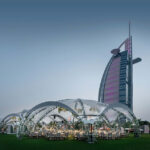Breaking previous records and outpacing projections, Dubai’s tourism sector has reinforced its position as a global powerhouse, with the emirate having welcomed 18.72 million international visitors in 20244 — a 9.2 per cent year-on-year (YoY) surge.
This growth underscores the city’s resilience, strategic investments, and its ability to capitalse on shifting global travel trends, tourism industry experts said.
With tourism now contributing over $179.8 billion in international visitor spending and supporting 7.75 million jobs regionally, Dubai is poised to redefine luxury, accessibility, and innovation in hospitality as it eyes 2025, industry analysts said.
Dubai now boasts the world’s largest inventory of hotel rooms, with 154,016 rooms across categories as of 2024. Dubai’s tourism infrastructure is set to expand further, with 3,000 additional rooms slated for completion by late 2025. Notable projects include the highly anticipated One & Only One Za’abeel, the Jumeirah Marsa Al Arab, and the expansion of Address Hotels’ portfolio. Industry experts highlight that 70 per cent of upcoming additions will target the luxury and serviced apartment segments, aligning with Dubai’s vision to attract high-net-worth individuals (HNWIs) and remote workers through initiatives like its virtual working programme.
Hospitality industry experts said a key catalyst for Dubai’s tourism boom has been its aggressive expansion of air connectivity. The resumption of direct Emirates flights to Nigeria in early 2024, coupled with a landmark interline agreement between Emirates and West Africa’s Air Peace, unlocked access to millions of travelers across Africa. This move not only bridged a critical gap in intra-continental travel but also positioned Dubai as the gateway between Africa, Asia, and Europe.
Western Europe remained Dubai’s largest source market, contributing 14.8 per cent of total visitors, while South Asia saw a notable 1.6 per cent increase. Analysts attribute this to Dubai’s targeted marketing campaigns and visa facilitation programs, such as the five-year multi-entry visa for Indian tourists introduced in 2023. Meanwhile, Saudi Arabia’s rising prominence as a business and leisure destination has created a symbiotic relationship, with Dubai benefiting from spillover traffic tied to Saudi Arabia’s Vision 2030 projects.
Having the world’s largest inventory of hotel rooms, the city’s accommodation strategy prioritises diversity: 64 per cent of rooms cater to the luxury and upscale segments (35 per cent five-star, 28 per cent four-star), while 19 per cent fall in the budget-friendly one-to-three-star range. Hotel apartments, popular among long-stay travelers and families, account for 17 per cent of the market.
Dubai’s Average Daily Rate (ADR) reached $154 in 2024, a significant rebound from pandemic-era lows of $108 in 2020–2021. While Riyadh ($168) and Jeddah ($160) currently lead the region due to Saudi Arabia’s booming business travel and MICE (Meetings, Incentives, Conferences, Exhibitions) sector, Dubai’s ADR growth reflects its ability to balance occupancy and premium pricing. Hotel occupancy averaged 78 per cent in 2024, up from 72 per cent in 2023, driven by events like the Dubai Shopping Festival, COP28, and a packed calendar of concerts and sports tournaments.
The travel and tourism sector’s contribution to the Middle East’s GDP skyrocketed by 25 per cent in 2023 to $460 billion, with Dubai at the epicentre. International visitors spent $179.8 billion in 2024—a 50 per cent YoY jump—while domestic tourism grew by 16.5 per cent, reaching $205 billion. The sector’s regional economic impact is projected to hit $507 billion in 2024, creating 550,000 new jobs. In Dubai alone, hospitality employs over 400,000 people, with roles spanning luxury retail, aviation, and event management.
Globally, 2024 marked a milestone with 1.4 billion international tourist arrivals—an 11 per cent increase from 2023—and $1.9 trillion in tourism export revenues, as per the UN Tourism World Tourism Barometer. The Middle East emerged as the fastest-recovering region, with arrivals 32 per cent above pre-pandemic levels. Dubai accounted for nearly 30 per cent of the region’s tourism revenue, aided by its early reopening post-Covid and investments in safety certifications.








